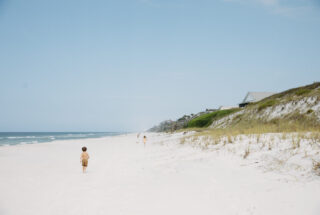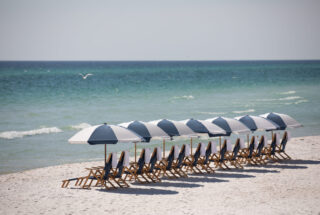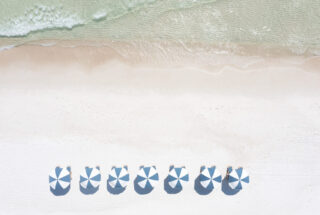An Instagram post led Zoe Mathews to pull off I-10 in Tallahassee on her way to Jacksonville. Cainnon Gregg was announcing a Pelican Oyster Company pop-up, and Zoe had to get a couple of sacks of Salty Birds—they’re that good.
Zoe, event manager for Alys Beach, met the oyster farmer at Harvest Food and Wine Festival where she got her first slurp of his briny bivalves and decided he would be a vendor for 30A Wine Festival’s Oysters & Champagne event. She’s been hooked ever since.
But it’s not just the tasty oyster she loves. It’s Cainnon’s approach. She elaborated, “He [shares] his process. I think that’s important—you’re not just eating an oyster, you’re seeing him out on his farm working in wind and rain; it’s not glamorous. Cainnon takes time to explain [oyster farming] to our attendees in a fun, approachable way. His energy is infectious and people love talking to him.”
But Cainnon wasn’t always an oyster farmer.


He attended a performing arts high school where he acted but also learned the finer points of sculpture and ceramics. He got a scholarship to pursue musical theatre, but decided against it, opting instead for an apprenticeship in Italian plasters. After four years, he was declared a master and started plying his Venetian plaster and gold gilding all over North Florida.
The tides changed when Urban Outfitters (UO) opened in Jacksonville. They were famous for hiring artists to do all their visuals. Cainnon applied.
He didn’t get the job, but a few months later on tour with his band, he stopped in Charleston, South Carolina. He went into UO to get some sunglasses, and the woman who didn’t give him the job in Jacksonville was at the register. She remembered Cainnon and asked how the job was going. He told her he didn’t get it. Surprised, she asked how soon he could move to Charleston.
With a duffel bag and a bicycle, Cainnon made his way to Charleston.
For the next ten years, he worked for UO, traveling to stores around the world, building art installations and large visuals.
While working for UO, Cainnon also freelanced, crafting hand-turned coffee spoons, custom wood installations, and various plaster projects under the brand Cainnon Handcraft. On the eve of a move to Tallahassee to help open a concept store at Florida State University, he took on one more project. He elaborated, “I built coffee stirring spoons for this shop in Atlanta and I was at that coffee shop when I met this young chef who saw the pieces I made. He asked me if I would make some reclaimed maple pastry tables, prep tables, and special surfaces for a new restaurant.”
While delivering the projects to Kimball House, Cainnon met Bryan Rackley. He added, “They invited me to their opening night where I tasted a West Coast oyster for the first time. I liked it. I grew up in Jacksonville.


I lived in Charleston. I ate oysters but I didn’t love oysters.”
Cainnon credits the Kimball House crew and their menu of sixteen different oysters with sparking his love for the bivalves, but it wouldn’t be the last time they crossed paths.
Settled in Tallahassee, Cainnon was dealt a blow. UO went through leadership changes and laid off all the artists. He still had his art side hustle, but his wife Kiki was due with their daughter and he didn’t know what to do.
“We didn’t want to move. I leaned into Cainnon Handcraft to sell my art. It started with hand-carved wooden pieces and it did well. We sold all over the world in boutiques in Seoul, Barcelona, Tokyo, London, and more. We were in Vogue magazine. We were stocked in a bunch of Urban Outfitters, but everything had to be made by me and I couldn’t keep up,” he said.
Enter oyster farming. It checked all his boxes: spending time outside, growing something, working
with nature.
He planned to run Cainnon Handcraft a few days a week and farm oysters a few days a week, but he fell in love with being on the water, flipping cages, watching the microscopic seed grow into the sometimes wonky, sometimes elegant, always tasty oysters he is known for.
Years had passed since Cainnon tasted oysters at Kimball House, but he knew he wanted his Salty Birds on their menu. He reached out to Bryan Rackley, reminding him of the pieces he built for their opening, and let him know he was planting oysters. Bryan told him to call when they were ready.
Then came Hurricane Michael, the 2018 Category Five tempest. “It destroyed the farm. I lost everything, but I had to work so I brought back Cainnon Handcraft while I rebuilt the farm,” Cainnon said.


Like with Hurricane Michael, the COVID-19 pandemic dealt a hit to Cainnon and his oyster farm. He again turned to his art when restaurants stopped buying oysters. He added, “I’m a master of Italian plasters and a master of carpentry so people will call me to build something crazy. I once built a thirty-foot hearth in Killeen black plaster, and then I bison waxed the entire thing.”
But oysters remain his passion. Cainnon starts his day with a morning meeting with the other farmers in the informally called “Spring Creek Oyster Collective.” Cypress Point and Shiny Dimes (Bryan Rackley’s brand-new farm) operate adjacent to Pelican and they all operate out of Spring Creek Marina. Cainnon helps Cypress sort oysters, the Shiny Dimes crew helps run down unmoored gear, they help each other flip cages, eat lunch together, and assist each other when a storm is brewing. Even though they are all growing oysters, it is not competition you feel at Spring Creek. It is respect and care for one another.
Wild, naturally growing oysters often have a different look than commercially-farmed oysters. Cainnon’s approach to farming is one that keeps the beauty of the wild oyster while infusing a bit of his personality into the crop. He elaborated, “My oysters might not be as uniform as other farms, but that’s intentional. I love a wild oyster. I love when oysters look different. I’m trying to cultivate them so they still have a lot of individuality which feels natural to me.”
With 300,000 oysters in the water, the farm keeps him busy. But a trip to St. Augustine inspired a new project that fuses his love of oyster farming and his sculptural art. Over the last year, he’s collected oyster shells from restaurants and events (including those at Alys Beach) to try his hand at making plaster from scratch. Inspired by sixteenth-century Spanish explorers’ use of tabby and coquina, Cainnon plans to build oyster tabby wall pieces and sculptures with plaster made from his collected shells.
“I spent so much time working with plaster, but now I grow the thing that makes plaster—it seems the perfect merging of my worlds,” he said. “I love working in the ocean. I love creating and growing something. Now oysters are my medium and my art is working with nature,” Cainnon added.













